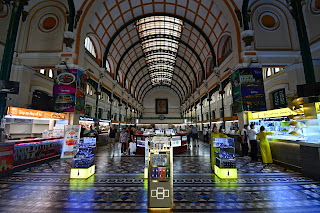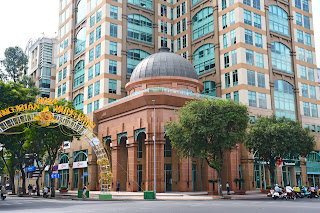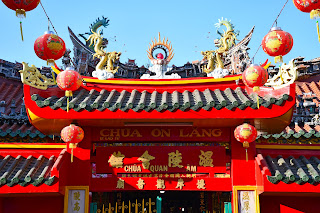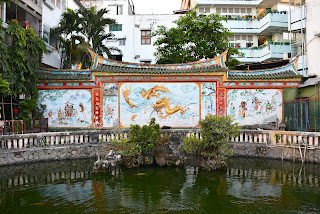Vietnam North to South – Day 14: Ho Chi Minh City
We spent the whole day today in Ho Chi Minh City, and I have to say it is quite different from Hanoi. Hanoi feels smaller, calmer, and more rigid, whereas Ho Chi Minh City is – as my dad put it – “what Bangkok was twenty years ago.” It feels distinctly more southeast Asian: the roads are busier and crazier, and the streets seem much more alive. Ho Chi Minh City is to Hanoi what New York is to Washington D.C. or what Hong Kong is to Beijing.
Of course, the
two cities are still more similar than different. Hanoi may be more fiercely
patriotic, but there are still flags on every corner in Ho Chi Minh City –
sometimes Vietnamese flags, sometimes a golden hammer and sickle on a red
background. Despite these outward displays of loyalty to communism, the
citizens of both cities love expensive cars and luxury brands, which are
heavily advertised in the streets. Small businesses and roadside stalls thrive
in both cities, though it is quite clear that Ho Chi Minh is more geared
towards wringing tourists dry of all their money.
In the
morning, we rode the tour bus to the Independence Palace, the erewhile
residence and workplace of the president of South Vietnam. Initiated by Ngô
Đình Diệm, it was only completed under the rule of the military junta that
ousted him from power and assassinated him. In 1975, a tank bulldozed its gates,
completing the fall of Saigon and heralding the end of the Vietnam War.
From
thence, we continued to the Central Post Office, completed in 1891 under French
rule and built in French style. Just across the road from this building stands
the equally European Notre Dame Cathedral of Saigon. Unfortunately, during the
time of our visit, its impressive front façade was covered in scaffolding,
which I believe has been there for several years. It is overgrown with plants
and very few people seem to actually work on the site.
The most
impressive area in Saigon is Nguyễn Huệ Boulevard, which begins at the People’s
Committee of Ho Chi Minh City (originally the French colonial city hall) and
offers views of several major attractions like the Ho Chi Minh Opera House and
Bitexco Tower. On the boulevard itself stands a statue of Ho Chi Minh, and
farther down an installation of two giant dragons. I am not sure whether the
latter is a permanent feature or was merely installed there for the year of the
dragon.
My dad and
I split from the group on the boulevard and ascended to the top of Bitexco
Tower, which offers impressive views of the whole city. After traversing the Bến
Thành Market and making a stop by the Hindu Mariamman Temple, we broke for
lunch. It was interesting to see the great number of local Vietnamese praying
at the very Indian-looking temple; I understand that superstition and unclear
religious boundaries have made it quite normal for Vietnamese people to worship
in Hindu temples and pray to Hindu gods even if they don’t see themselves as
Hindu.
Leaving our
purchases at the hotel, we spent the rest of the day touring pagodas and other
places of worship. We started by taking the taxi to the Jade Emperor Pagoda,
and then took another taxi to Cholon, a neighbourhood west of the city centre.
There, we visited a number of temples: the Chinese-style Ba Thien Hau Temple
with its detailed depictions of Chinese legends, the swarming Ông Temple with
prayers dangling from its incense spirals, the sleepy Cholon Mosque, the red
and black Tam Sơn Hội Quán Pagoda, and the richly decorated Quan Âm Temple
dedicated to Guanyin. Each of the Buddhist (and Taoist) establishments was
packed with visitors in a display of religiousness I have not seen in a long
time.
In the
evening, my dad and I managed to make bookings for trips to undertake in the
next few days: we will be heading to Vũng Tàu and the Mekong River Delta.






















































Comments
Post a Comment